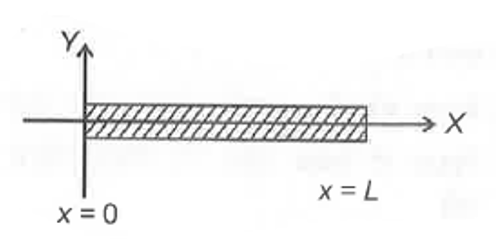A thin rod AB of length a has variable mass per unit length where x is the distance measured from A and is a constant.
Rod is freely pivoted at A and is hanging in equilibrium when it is struck by a horizontal impulse of magnitude P at the point B. Find the angular velocity with which the rod begins to rotate.
The correct Answer is:
Step by step video, text & image solution for A thin rod AB of length a has variable mass per unit length rho_(0) (1 + (x)/(a)) where x is the distance measured from A and rho_(0) is a constant. Rod is freely pivoted at A and is hanging in equilibrium when it is struck by a horizontal impulse of magnitude P at the point B. Find the angular velocity with which the rod begins to rotate. by Physics experts to help you in doubts & scoring excellent marks in Class 12 exams.
Topper's Solved these Questions
- BOOK - MOTIONCHAPTER - 10 ROTATIONALEXERCISE - Exercise - 4 (Level - I)24videos
10 ROTATIONAL
- BOOK - MOTIONCHAPTER - 10 ROTATIONALEXERCISE - Exercise - 4 (Level - II)49videos
10 ROTATIONAL
- BOOK - MOTIONCHAPTER - 10 ROTATIONALEXERCISE - Exercise - 3 (Level - I)27videos
10 ROTATIONAL
- BOOK - MOTIONCHAPTER - ALTERNATING CURRENTEXERCISE - EXERCISE - 4 (LEVEL - II)14videos
ALTERNATING CURRENT
Similar Questions
A thin rod AB of length a has variable mass per unit length ρ0(1+xa) where x is the distance measured from A and ρ0 is a constant.
Find the mass M of the rod.View SolutionA thin rod AB of length a has variable mass per unit length P0(1+xa) where x is the distance measured from A and ρ0 is a constant.
Find the position of centre of mass of the rod.View Solution
Knowledge Check
- Question 1 - Select One
A uniform thin rod AB of length L has linear mass density μ(x)=a+bxL, where x is measured from A. If the CM of the rod lies at a distance of (712L) from A, then a and b are related as :_
A2a=bB3a=2bCa=2bDa=b - Question 2 - Select One
The centre of mass of a non uniform rod of length L, whose mass per unit length varies as ρ=k.x2L where k is a constant and x is the distance of any point from one end is (from the same end)
A(34)LB(14)LC(16)LD(23)L - Question 3 - Select One
A uniform rod AB of mass m and length 2a is falling freely without rotationb under gravity with AB horizontal. Suddenly the end A is fixed when the speed of the rod is v. The angular speed which the rod begains to rotate is
Av2aB4v3aCv3aD3v4a
A thin rod AB of length a has variable mass per unit length ρ0(1+xa) where x is the distance measured from A and ρ0 is a constant.
Find minimum value of impulse P if B passes through a point vertically above A.View SolutionA thin rod AB of length a has variable mass per unit length ρ0(1+xa) where x is the distance measured from A and ρ0 is a constant.
Find moment of inertia of the rod about an axis passing through A and perpendicular to AB.View SolutionThe centre of mass of a non-uniform rod of length L whose mass per unit length λ is proportional to x2, where x is distance from one end
 View Solution
View SolutionThe density of a linear rod of length L varies as ρ=A+Bx where x is the distance from the left end. Locate the centre of mass.
 View Solution
View SolutionA chain of length L and mass per unit length ρ is piled on a horizontal surface. One end of the chain is lifted vertically with constant velocity by a force P.
View Solution
